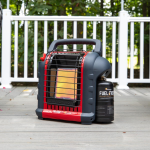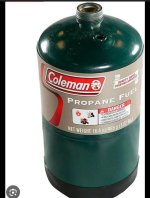I would be sure I had a working CO2 detector. If it's all you got.. it is what it is. I would probably head for my truck with pipe and tobacco. How cold does it get in your area? We talking pipes freezing or just uncomfortable?Its not ideal I agree. What would you do in cold weather and no electricity?
Room Heater
- Thread starter Flatfish
- Start date
You are using an out of date browser. It may not display this or other websites correctly.
You should upgrade or use an alternative browser.
You should upgrade or use an alternative browser.
SmokingPipes.com Updates
Watch for Updates Twice a Week
I have used the Mr. Buddy propane heater (pictured in your first post) for many years. I use it with a 20 pound tank. Because it's catalytic heater, CO is not a concern. What is a concern:
- The ceramic element puts out a lot of heat. The unit should be kept a good distance from anything that can burn.
- The unit consumes oxygen. It has a low oxygen cutoff sensor, but like all thinks mechanical, err on the side of caution and provide some outside air to the room.
- The propane bottle or tank can leak, so leak-test all connections, especially after moving the heater or propane tank.
Yet they can still give off carbon monoxide so I'm rather puzzled.
Counter-intuitive as it may seem, a device that "burns" at so low a temperature that flame is not produced, probably stands a *greater* risk of releasing unsafe amounts of carbon monoxide, because carbon monoxide is one of the things left over from incomplete combustion.
I don't know much about gas, but with wood stoves, your risk of carbon monoxide is not when the fire is blazing at a good clip, but when it's burning low and the ignition of all possible combustables (such as carbon monoxide) is less efficient.
High heat burns off carbon monoxide.
Back in the 80s I used to have a Calor Gas room heater. They were quite popular. They use a similar type of heaters for caravans and mobile homes.
Mike
Mike
I too had one of those in the 80's and it always gave me a headache after roughly one hour of use.Back in the 80s I used to have a Calor Gas room heater
I will confess I had all the windows closed though
Jay.
I always used to get headaches. My grandparents had mains gas. Almost guaranteed a headache when I visited them. Sometimes vomiting.
Well I certainly hope you get something sorted, as I'm sure you're aware, the forecast for your neck of the woods (mine too) looks pretty bleak for at least a week.Only for temp use.
How is your wi-fi connection going, is it sorted yet or are you still travelling to places miles away just to connect?
Jay.
The weather does look a bit bleak, but no snow falling yet.
I'm still without wifi at home nearly a month after the storm.
I'm at a different location to write this.
My wife and I have decided that given our powercuts are rare and generally short, we'll just stick on a few extra layers.
I'm still without wifi at home nearly a month after the storm.
I'm at a different location to write this.
My wife and I have decided that given our powercuts are rare and generally short, we'll just stick on a few extra layers.










